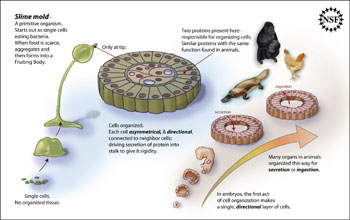Multimedia Gallery
How Slime Mold Gets Organized
When food is scarce, the separate cells of a slime mold--a unicellular organism--aggregate and form what is called a fruiting body. Cells at the tip of the fruiting body organize into a formation very similar to the epithelial layer of cells found in many organs of higher animals. National Science Foundation-supported researchers found that the proteins responsible for organizing cells at the tip of the slime mold's fruiting body are genetically very similar to those that perform the same function in animal cells.
To learn more about this research, see the NSF press release "How the Slime Mold Gets Organized."
Credit: Zina Deretsky, National Science Foundation
Images and other media in the National Science Foundation Multimedia Gallery are available for use in print and electronic material by NSF employees, members of the media, university staff, teachers and the general public. All media in the gallery are intended for personal, educational and nonprofit/non-commercial use only.
Images credited to the National Science Foundation, a federal agency, are in the public domain. The images were created by employees of the United States Government as part of their official duties or prepared by contractors as "works for hire" for NSF. You may freely use NSF-credited images and, at your discretion, credit NSF with a "Courtesy: National Science Foundation" notation.
Additional information about general usage can be found in Conditions.
Also Available:
Download the high-resolution JPG version of the image. (294 KB)
Use your mouse to right-click (Mac users may need to Ctrl-click) the link above and choose the option that will save the file or target to your computer.



